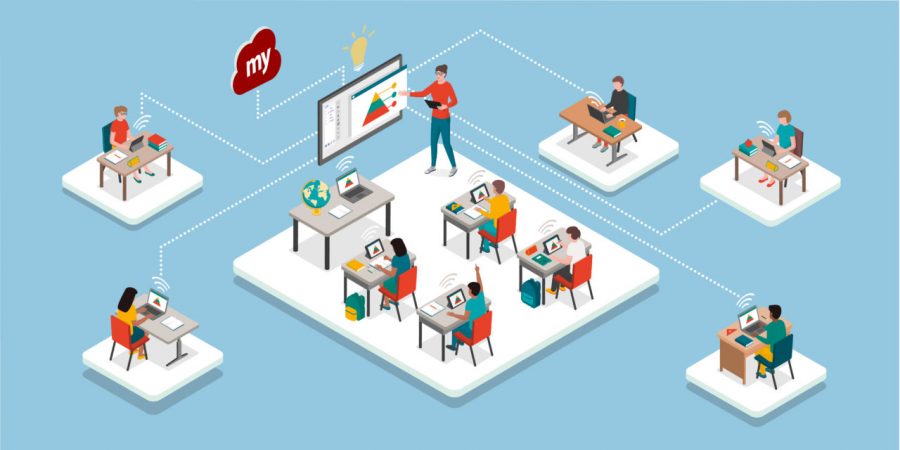Navigating a New Normal
Yellow crime tape barricaded doorways to empty hallways. Bare lockers gaped open like hungry mouths. A once-bustling building now deserted.
This was a familiar sight for nearly every school in the United States back in March of 2020 when thousands of school districts across the country closed down due to COVID-19.
The temporary fix? Online learning.
Teachers scrambled to set up Zoom calls and upload homework to Google Classroom. Interactive classwork dwindled into thirty-minute sessions, where teachers talked to twenty black boxes with red mute buttons. In some schools, a no assessment policy had only one result: what went into one ear of a student came back out the other.
Based on how online schooling progressed in March, it’s pretty clear that many districts weren’t prepared to switch to remote learning.
However, after six months of careful planning, schools are cautiously reopening and maintaining social distancing regulations by adopting a newly organized hybrid model.
Two months into the semester, this new system has stirred up mixed reactions from parents, teachers, and students alike. Is this new schedule helping or harming my child? Do we have enough time to cover the material I need to teach? And perhaps the most baffling question of all, should schools continue to use this hybrid model even after the pandemic ends?
What Exactly Does “Hybrid” Mean?
There are different types of hybrid learning with slight variations in each, but most of them involve two groups of students. For those who are unfamiliar with the systems, here’s what two of them look like:
System A: one group goes in during the “AM period”, while the other group comes during the “PM period”. Therefore, each student will get a half-day in school and complete the rest of their school day at home.
System B: each group goes to school on alternating days (i.e. Group 1 on Mondays, Wednesdays, and Fridays, and Group 2 on Tuesdays and Thursdays). On the days when students are not going into school, they are participating in virtual classes.
Some school districts, like North Colonie, also offer a choice between all remote and hybrid learning. All remote students take part in hybrid classes through video calls and submit assignments through online platforms.
Regardless of which system a student chooses, they are bound to experience both benefits and drawbacks.
The Benefits of the Hybrid Model
So exactly how many positives are there to a hybrid model?
The first example definitely benefits some—those who struggle to finish assignments on time—more than others.
Depending on how much content students were able to learn, almost every teacher is constantly changing test dates. They are also cushioning their deadlines with the term “tentative”, promising to keep their schedules flexible during these unprecedented times.
In fact, “flexibility and agility are personality characteristics that we have to have,” claims Scott Muri, the superintendent of the Ector County Independent School District in Odessa, Texas. Muri says that without flexibility, “you are not going to survive this year, and kids are going to struggle.”
And as a result of flexible schedules, some students are finding that the hybrid model causes less stress.
A Shaker High School student reports that his half days give him more time to complete his homework and sleep early.
Students who found themselves staying up late to finish assignments and projects in the past may benefit from the extra time that the hybrid model creates.
In addition to flexibility and less stress, studies show that online learning helps students participate in class discussions.
A study conducted by the California State University shows that students who attended classes remotely found participating less daunting, and therefore were more engaged during class discussions.
For introverted students, this may be the solution to raising their participation grades. Studying from the comfort of their homes can ease them into the practice of sharing their ideas with others, thus accelerating their learning processes.
The Drawbacks of the Hybrid Model
Despite its numerous benefits, the hybrid model also presents some disadvantages.
The most prominent (and inevitable) obstacle: technical issues. Although the technology we have today is quite advanced, it is bound to have a few flaws.
A senior at Shaker High School, who opted to go fully remote this year, claims that earlier in the year, he “was kicked out of [his] Spanish Zoom [call] three times.” Another student says that she had trouble connecting to her class and had to shut down her Chromebook entirely.
A powerful but faulty tool, the technology designed to facilitate learning is causing unnecessary stress.
Similarly, the issues that arise from learning at home pose as hindrances for not just students, but also teachers.
One student stated that his teacher “suffers from having to constantly keep her dog quiet”, a problem that many families with pets face. Neighbors mowing lawns, a younger sibling crying—these are just a few of the issues that will potentially distract students from getting the full learning experience at home.
The hybrid model also creates problems for parents as well. Students who are learning virtually need constant monitoring, especially younger children. Furthermore, in a household where both parents are working, it is difficult to juggle a job and a child.
According to Lindsey Walder, CEO of Worldwise Tutoring, this is due to a socioeconomic imbalance of this system. Low-income families who are unable to work from home or hire a tutor can’t afford to use the hybrid model.
Therefore, if schools decide to keep the system in the future, lower economic classes will be discriminated against. Global pandemic or not, some families just don’t have the freedom to choose the hybrid model.
Besides the socio-economic issue, another major downside to the new school system is the loss of social interaction with peers and teachers.
According to a Shaker High School remote student, she struggles in her classes because of the lack of after school help. Other students—both remote and hybrid—found that the absence of a classroom setting was an additional stressor.
While learning in bed every other day is a tempting choice, the problems and stressors raised by the hybrid model may steer some schools away from choosing it as a permanent solution.
Planning Ahead: How Does One Choose?
With so many advantages and disadvantages, it is difficult to determine whether or not schools should keep their hybrid models in the future. So how exactly does one decide?
Take time to sit down and think. Will a hybrid model help students succeed, or should schools revert back to the traditional schedule? Carefully meditate over the effects of hybrid learning, both positive and negative. For many families, the education of students is one of many concerns; we should focus on what will help students flourish.
If you are a parent, talk to your child. Are they able to handle online learning? How are they feeling about this school year so far? As Scott Muri said, flexibility is vital during changing times. It is important to keep an open mind and listen to your child before you voice your concerns about their choices.
Keep an eye out for any news. The schedule for future school years remains unknown to us. Factors like increasing outbreaks, can either push schools to return to normal or pull them deeper into the hybrid model. With constantly changing circumstances, we need to stay updated.
If you’re still uncertain about which educational system to choose, you won’t need to fully commit to a schedule yet. Until we eradicate COVID-19, schools will continue to use the hybrid model, and it doesn’t look like the virus will be gone soon.
Or perhaps, as we approach colder months, increasing outbreaks will force schools to shut down completely.
The future—our future—remains uncertain.
(she/her/hers)
Claire Kim is a senior and an editor at the Shaker Bison. She is also a member of Tri-M and Wind Ensemble. Outside of school, Claire...


